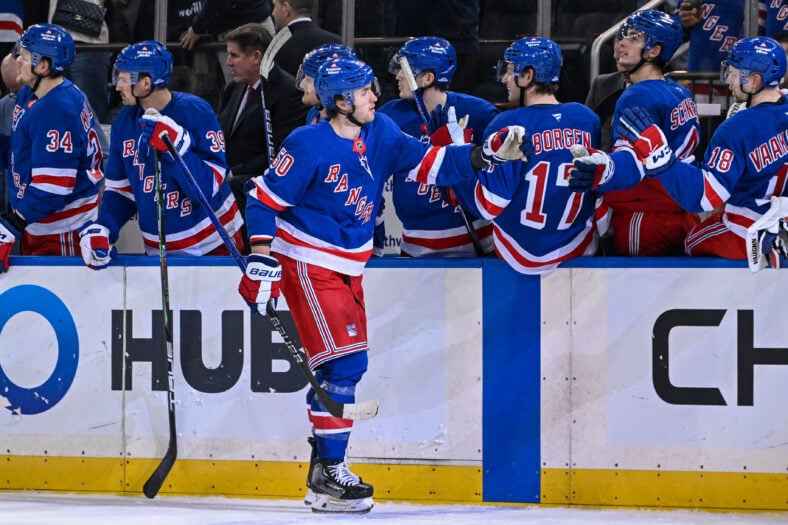There’s uncertainty, opportunity with Rangers power play after Chris Kreider trade
When the New York Rangers traded Chris Kreider to the Anaheim Ducks this offseason, it was an end of era. Gone is their longest tenured player. And perhaps nowhere will his absence be felt more than on the power play.
However, Kreider’s departure creates both uncertainty and opportunity with New York’s power play.
Kreider is tied with Camille Henry for most power-play goals (116) in Rangers history. He scored 69 power-play goals from 2020-25, fourth-most in the NHL behind Leon Draisaitl (108), Sam Reinhart (82) and Steven Stamkos (73), and two more than Auston Matthews. In 2021-22, Kreider led the NHL with a career-high 26 PPG.
The 34-year-old fell off last season, though. Plagued by injuries that limited him to 68 games, Kreider scored only six power-play goals – his lowest season total since 2016-17. It wasn’t just because of him, but the Rangers power play plummeted to 28th in the NHL at 17.6 percent last season. In 2023-24, Kreider scored 18 power-play goals and the Rangers were third in the League, converting at 26.4 percent.
Related: Why Rangers should pay close attention to Connor McDavid contract messaging: ‘all options on table’
Rangers need to replace Chris Kreider on top power-play unit

Even before Kreider was traded, change was in the air for New York’s power play. Kreider was bounced off the top unit at times, J.T. Miller arrived late last January, in a trade with the Canucks, and then-coach Peter Laviolette juggled combinations a bit to try and revive the power play and help save a lost Rangers season.
Mike Sullivan’s arrival as coach this season could bring more change to a power play that had grown stale. Then Kreider was traded.
The 13-year veteran needs to be replaced permanently on PP1, and that’s no small thing. Kreider’s down season somewhat obscures the fact that opponents focused on neutralizing him on the man advantage, which opened up chances for Mika Zibanejad and others. Kreider’s abilities to deflect pucks and screen goalies are perhaps better than anyone else’s in the League. The Rangers built a good portion of their power-play approach around that, along with Kreider’s proficiency at redirecting in passes from the side of the net.
Now, the Rangers must change things up without Kreider. Sullivan could choose a familiar veteran group with Adam Fox, Artemi Panarin, Vincent Trocheck, Zibanejad, and Miller on PP1. Or a couple of their young core players could battle to take Kreider’s spot, with, perhaps, Miller, Zibanejad, or Trocheck anchoring the second power-play unit.
In this scenario, Will Cuylle and Alexis Lafreniere appear to be the overwhelming favorites to graduate onto PP1 with Kreider gone – or perhaps both could work their way into significant roles on the top power-play unit by season’s end.
Coming off a breakout season, it’s Cuylle who might have the inside track to at least initially assume Kreider’s spot on PP1. The 23-year-old posted career highs of 20 goals and 25 assists, and the Rangers signed him to a two-year, $7.8 million bridge deal this summer.
The 6-foot-3, 212-pound power forward could replace the loss of Kreider’s net-front presence, a vital role on the power play. It’s a natural spot for Cuylle, whose rugged style leads to him spending plenty of time around the opposing crease. Also like Kreider, Cuylle has shown a proficiency for scoring tip-in goals, a skill that seems sure to become even sharper with more time spent as the net-front guy on PP1.
Related: How J.T. Miller ‘handled taking sh**’ from Rangers veterans as rookie
Alexis Lafreniere should be in line for more power-play time with Rangers – if he earns it

Lafreniere is coming off a season that alarmed the Rangers organization and should prompt some soul-searching from the 23-year-old forward. He followed up what looked like an emergent 2023-24 campaign by regressing substantially. The top overall pick in the 2020 draft recorded 57 points (28 goals, 29 assists) two seasons ago and was perhaps the Rangers best forward in the Stanley Cup Playoffs that spring. But he managed only 45 points (17 goals, 28 assists) in 2024-25 and saw his 200-foot game crater as well.
That said, Lafreniere, who signed a seven-year, $52.15 million extension in October, should be more than ready to receive expanded power-play time after getting so little of it over the first five years of his career. Lafreniere has scored only seven career power-play goals, with his other 85 coming at even strength.
Based on skill and pedigree, Lafreniere could get the nod over Cuylle. But Cuylle could be the better fit. Lafreniere’s going to have to earn this opportunity, even if many believe he finally deserves the chance to get major power-play minutes.
Where he fits is the question. Lafreniere could try to replicate the Kreider role, though that doesn’t appear to be his strong suit. He could come off the right-wing wall, though Miller could fill that role, too. Is he an option to replace Trocheck in the bumper position? If so, Miller and Zibanejad would have to win a lot of face-offs, something Trocheck is a master at.
Rookie Gabe Perreault is a sleeper option here. Though if he makes the opening-night roster, Perreault likely is a better option on PP2. That second unit could have a much different look if Perreault and fellow rookie Scott Morrow earn spots there, and either Trocheck or Miller is the anchor.
As with any training camp under a new regime, it’s likely that it won’t take long to find out what Sullivan is thinking.
